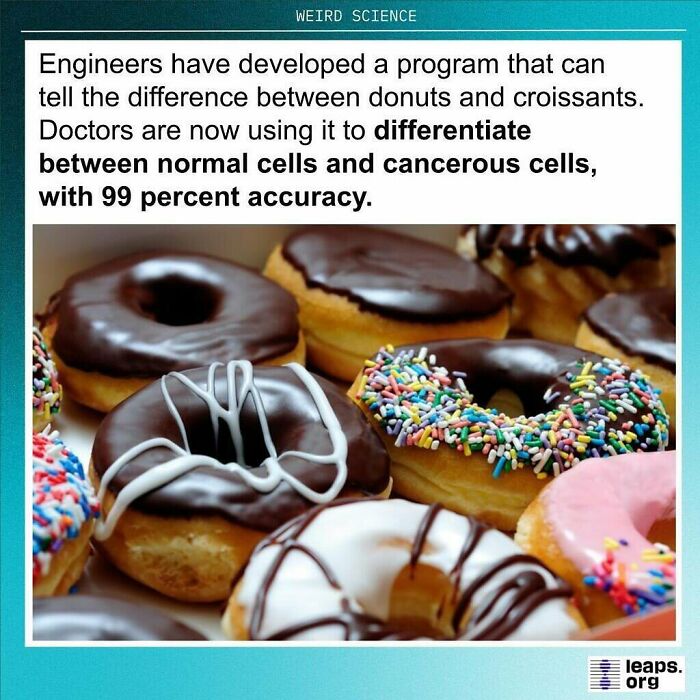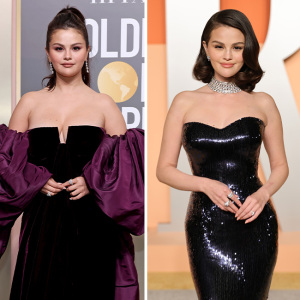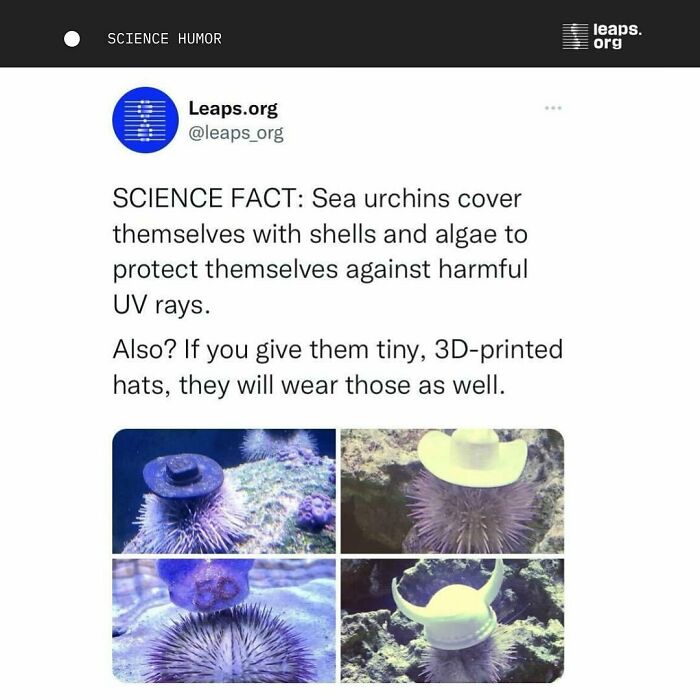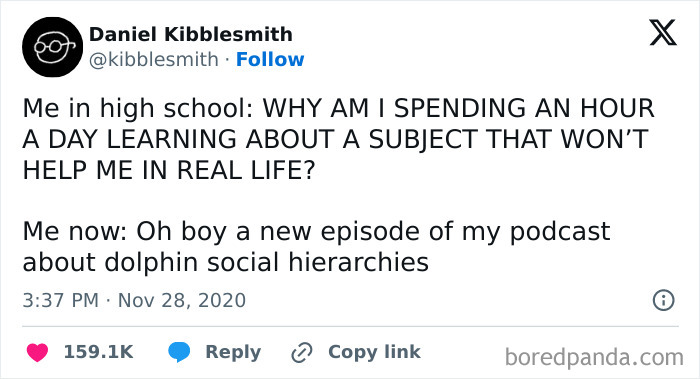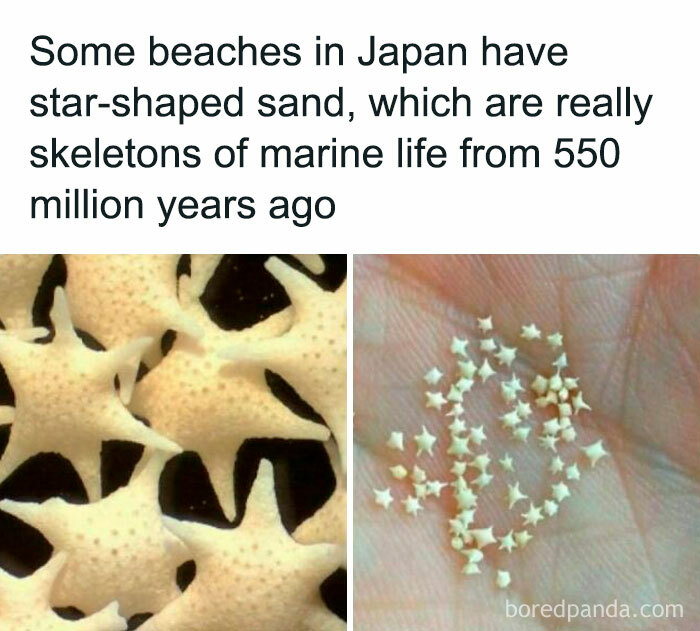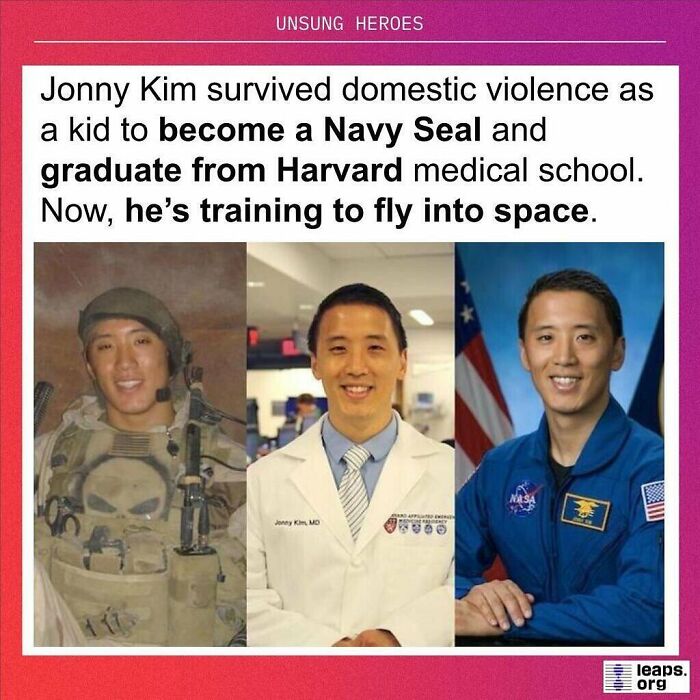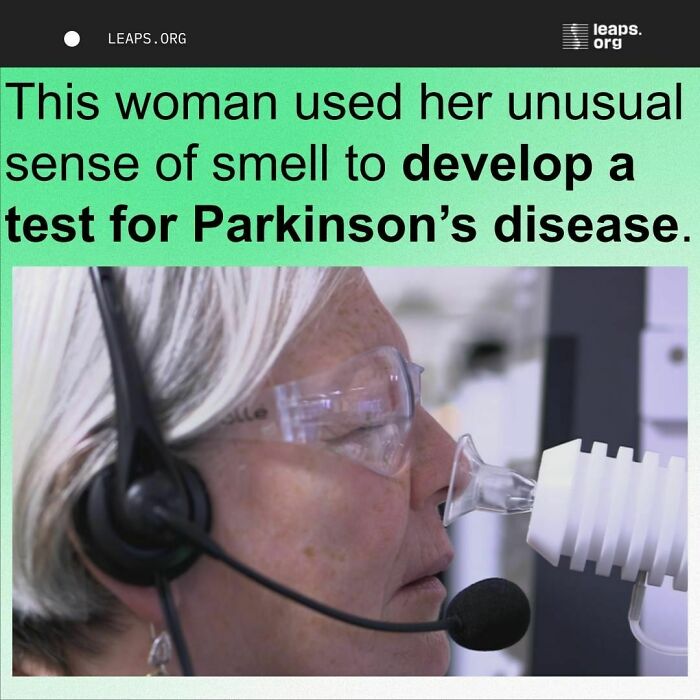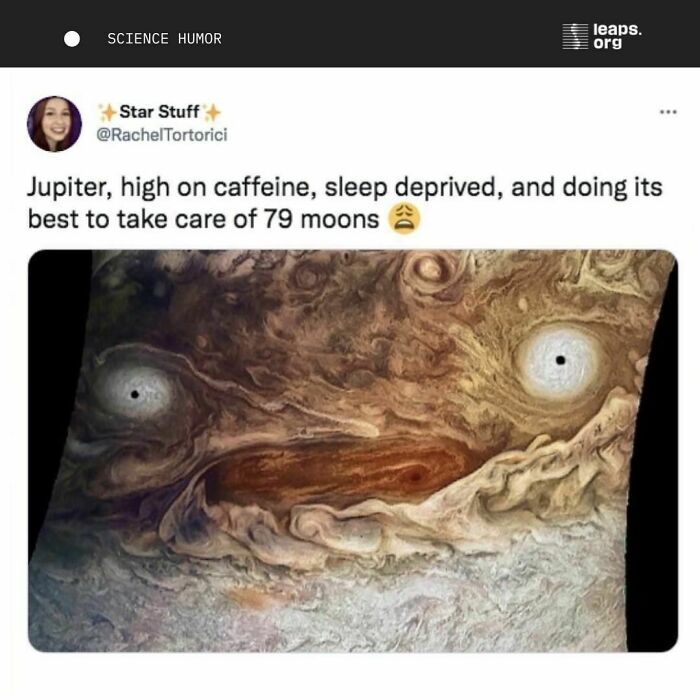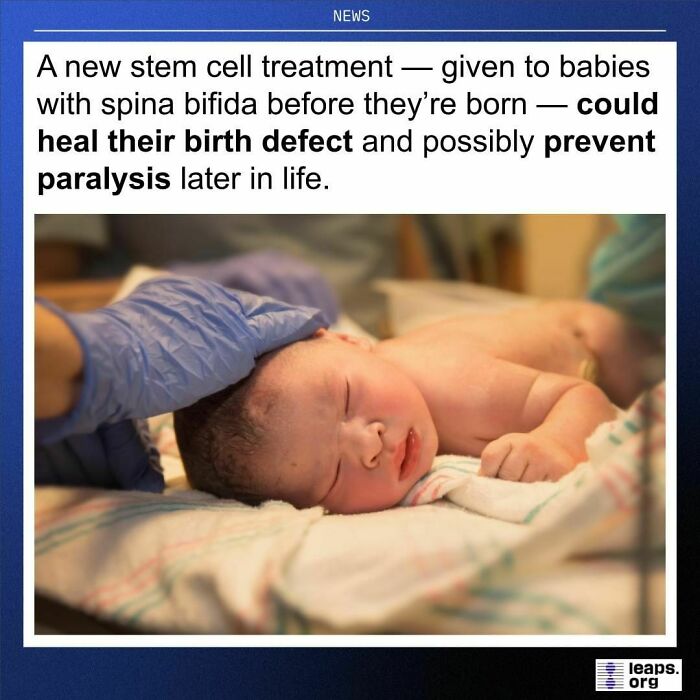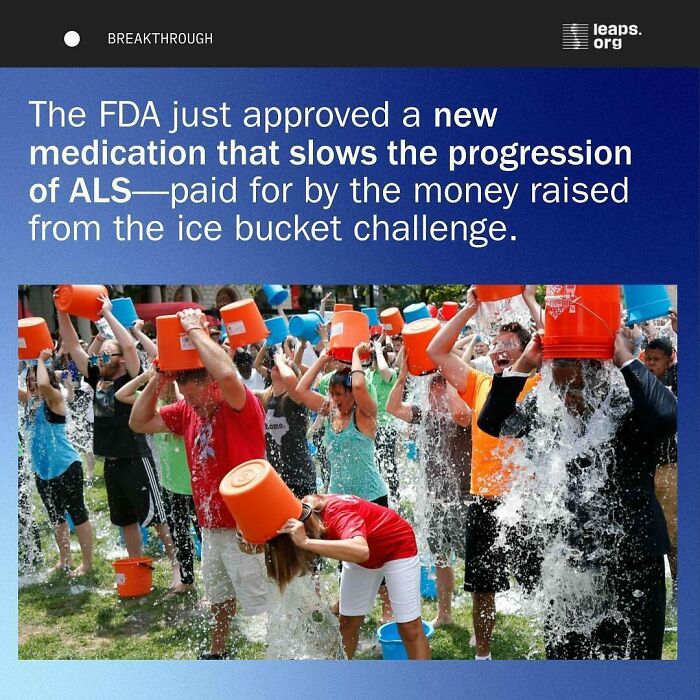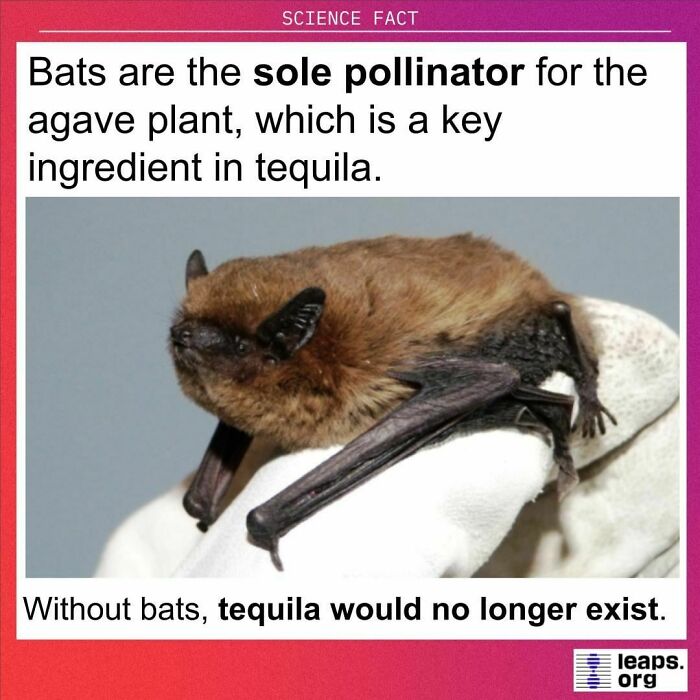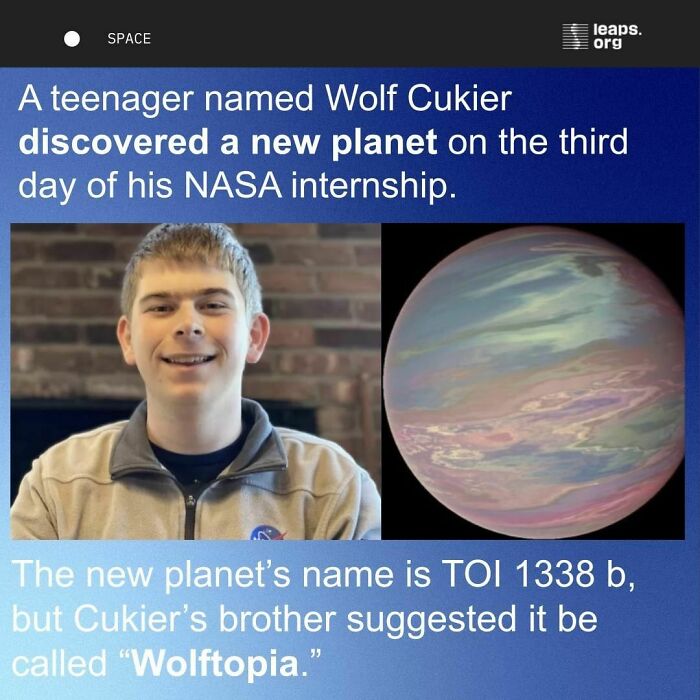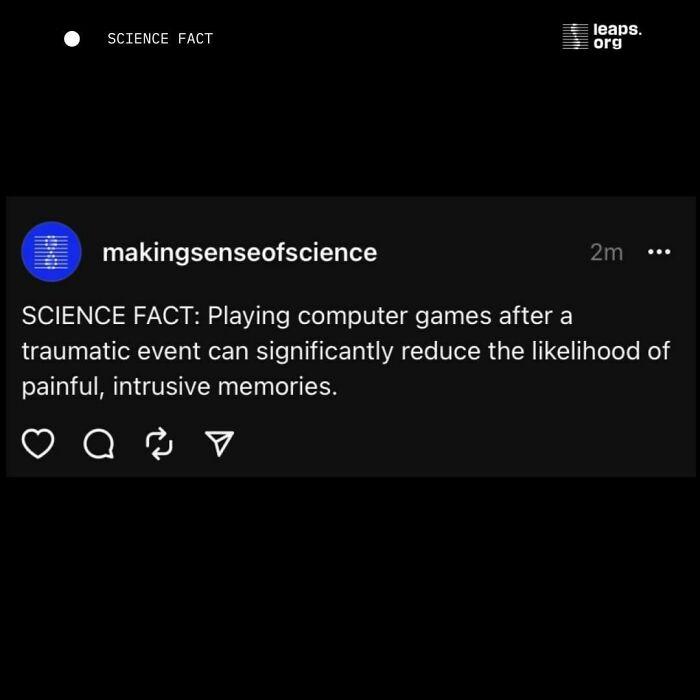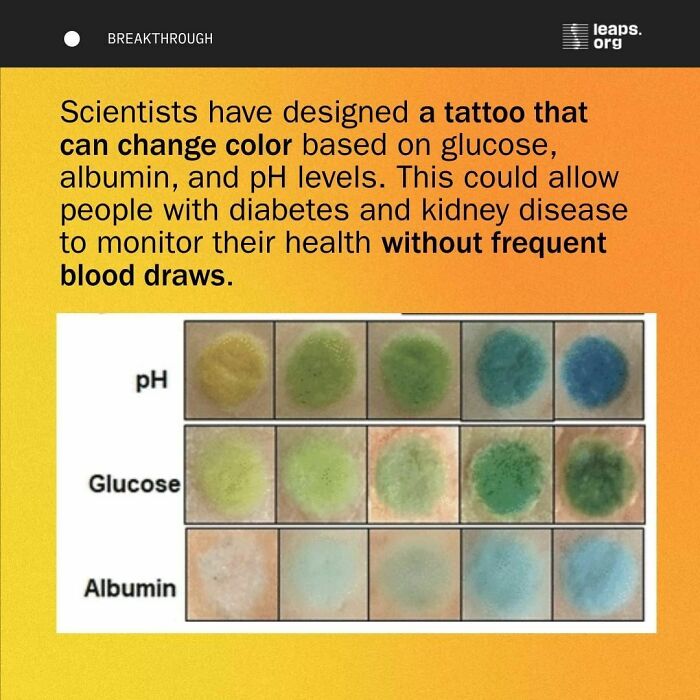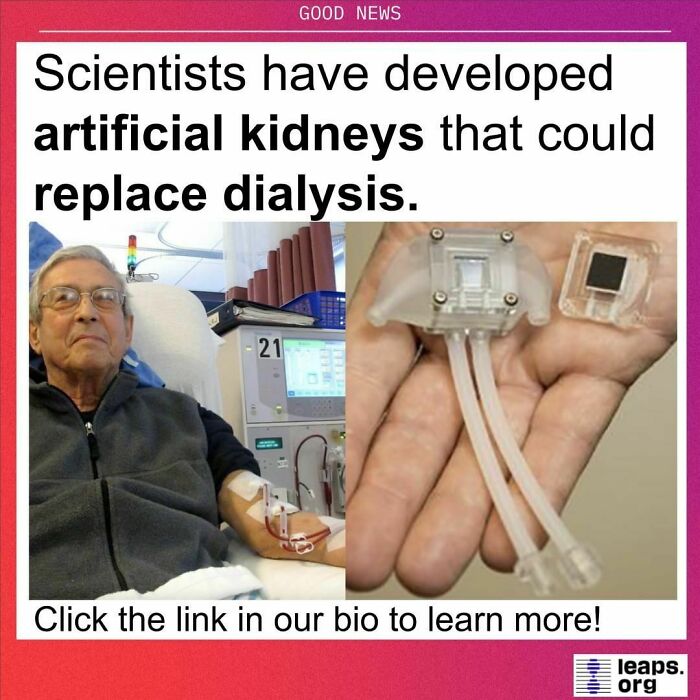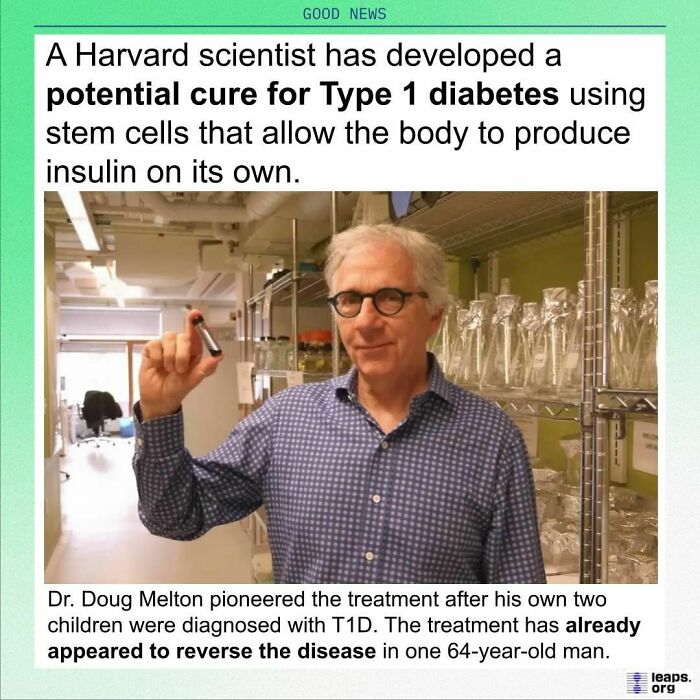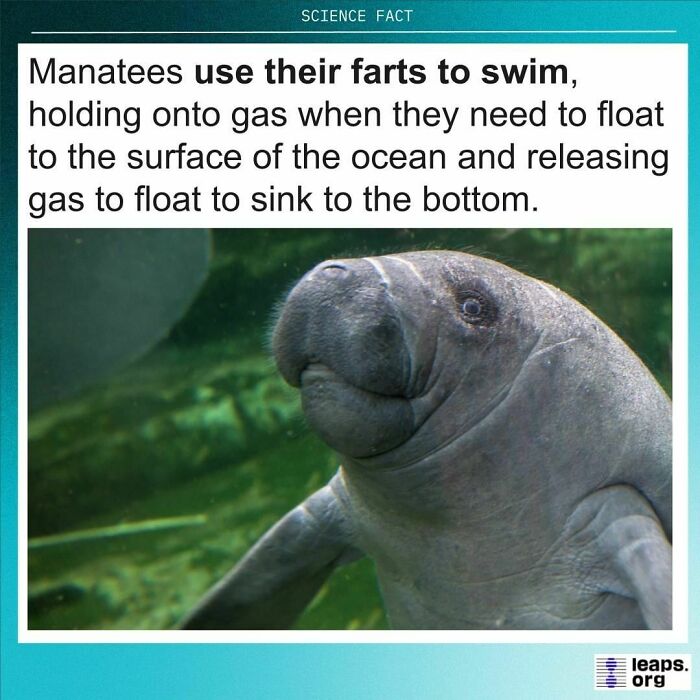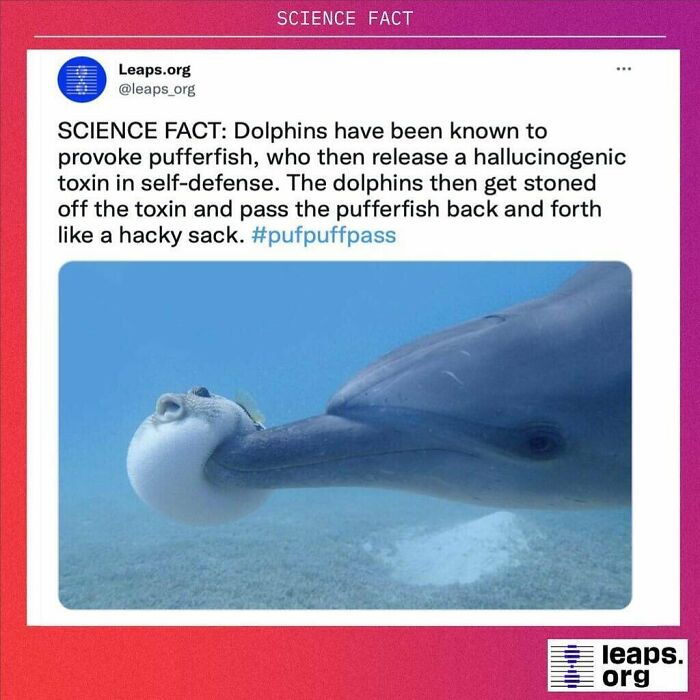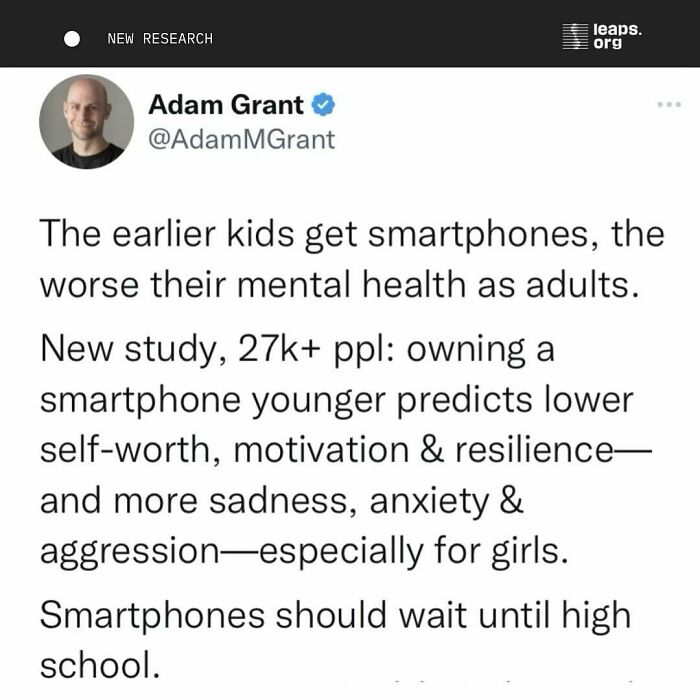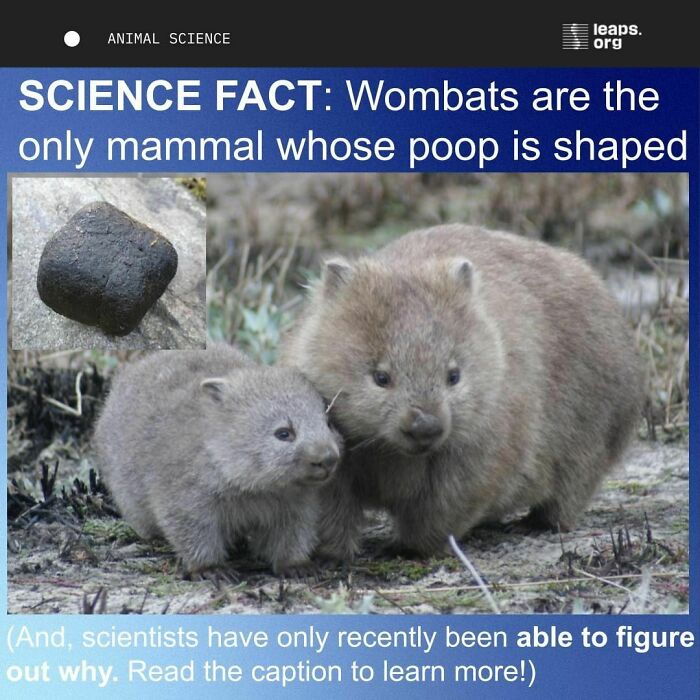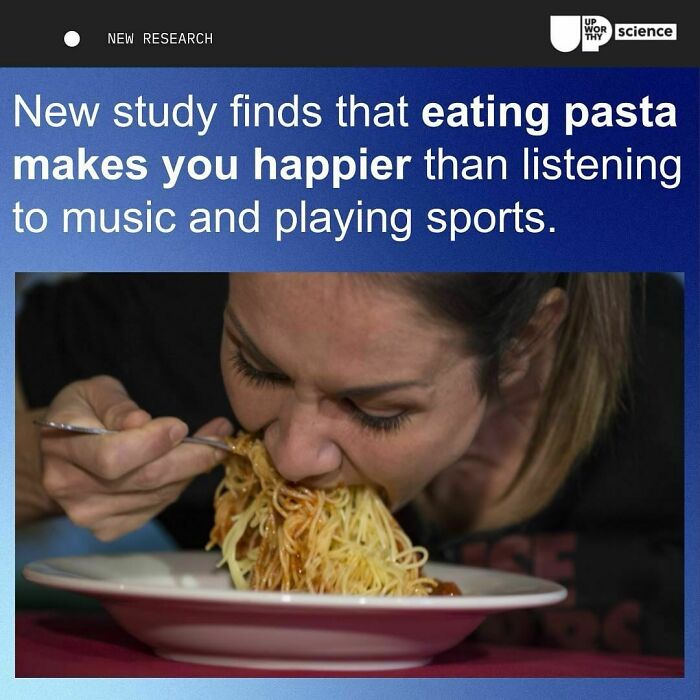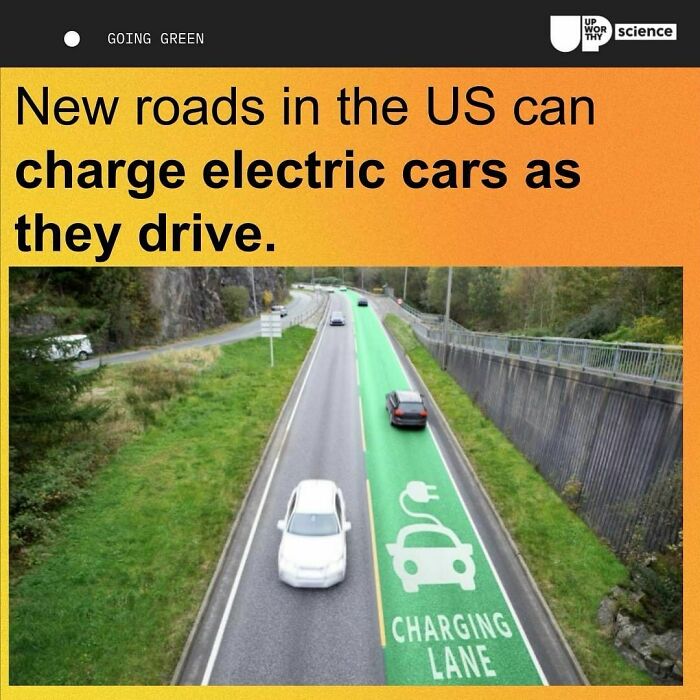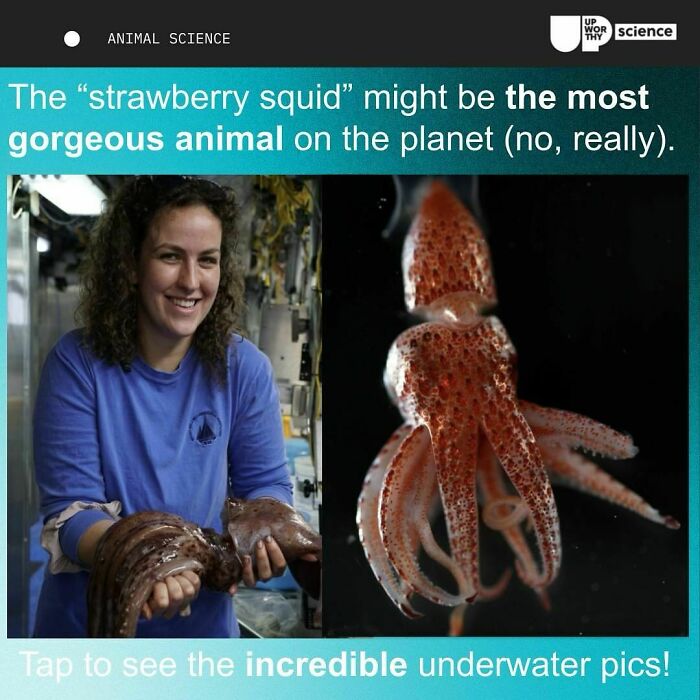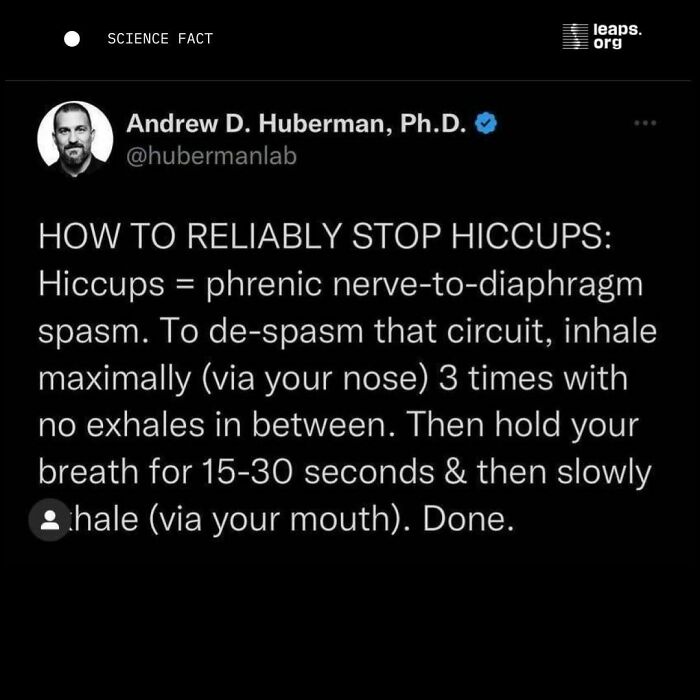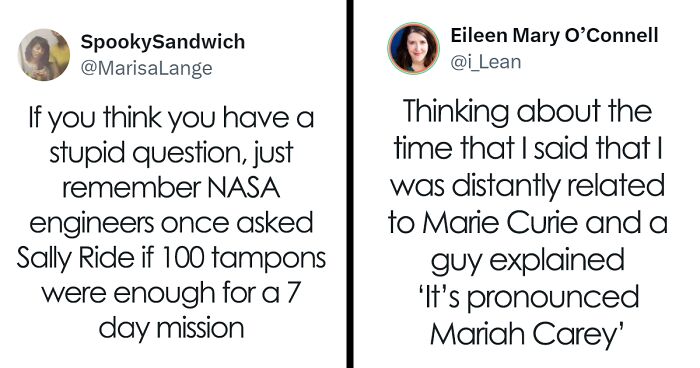
50 Positive Science Posts To Remind Us Of All The Good That’s Happening In The World
Positive news is underrated! It’s easy to get into the habit of thinking the world’s going downhill. Sure, it’s not all sunshine and rainbows all the time, but objectively speaking, there’s a lot to be happy about and proud of. However, we’re hard-wired to prioritize negative news, so we can all use a reminder about all the good things out there.
Case in point, the popular ‘Upworthy Science’ account on Instagram posts updates about all the wonderful progress happening in the scientific world, both on a global and local scale. We’ve collected some of the most uplifting bits of science news they’ve featured to share with you, Pandas. Scroll down to check them out!
More info: Instagram | UpworthyScience.com
This post may include affiliate links.
Chances are you’ve never heard of Guinea worm disease, a parasitic sickness which often causes infection, lock jaw, joint infections, and permanent disability. Decades ago, the disease afflicted 3.5 million people each year — but thanks to the heroic efforts of Dr. Donald Hopkins and others, there are currently just 28 cases of Guinea worm disease worldwide. Hopkins, born in Miami in 1941, grew up in poverty, the seventh of ten children. On a study-abroad trip to Egypt, Hopkins saw the devastating effects of disease on the global population and decided to pursue medicine. After graduating medical school at the University of Chicago (the only black student in his graduating class), Hopkins went on to work with the CDC to eradicate smallpox in Sierra Leone. At the time (1967) Sierra Leone had the highest smallpox rate in the world. Hopkins’ unique vaccination strategies helped Sierra Leone report their last case of smallpox just two years later. In the early 1980s, Hopkins set out to destroy another debilitating disease — Guinea worm. The disease, caused by unclean drinking water, affected millions across Africa at the time, but Hopkins was undeterred: “When people said to me, ‘You’re not going to be able to eradicate Guinea worm disease,’ I had heard all of that about smallpox. So I just brushed it off.” For decades, Hopkins (working alongside former president Jimmy Carter) has traveled across Africa and battled cultural differences, political rivalries, bad roads, and dilapidated health systems to bring clean water and larvicide to struggling populations. With just 28 cases worldwide in 2021, Hopkins and his team are on the verge of declaring victory — but the 79-year-old scientist won’t retire until the disease is completely gone: “I’ve got the tiger by the tail and I can’t let go.”
Wait, smallpox was eradicated so recently that the guy who helped do it is still alive?!
When reading, watching, and listening to the news, you should try your best to strike a balance between staying informed and avoiding drowning in anxiety. Negative news is more popular because human beings tend to focus more on information that could potentially relate to their survival.
The drawback is that negative news can raise our stress levels, make us anxious, and even affect our sleep.
By banning the use and new production of CFCs, the Montreal Protocol eliminated a significant contributor to climate change. It’s estimated that these efforts avoided a temperature increase of as much as 2.5 degrees. We love to see people working together to use science for the good of humanity
We as a GLOBAL SPECIES fixed a thing. It can be done for other things too. The biggest lies are they ones the people exploiting the planet for profit tell the rest of us to dissuade us from doing things to make things better. Thinking of a particular Orange Maniac who rages against electric cars.
It’s vital to remember that a lot of news in this day and age is pure sensationalism. The goal is to make you feel strong emotions (anger, fear, disgust, etc.). That way, you spend more time obsessing about what’s reported.
You’re also more likely to reshare it with the people you know, and then, the news continues to go viral. Positive news is more grounded, tame, and healthier.
A 13-year-old girl named Alyssa has been totally cleared of a deadly, incurable cancer after doctors used a technology called “base editing” to build her a new, living medication. Alyssa was diagnosed with T-cell acute lymphoblastic leukemia in May of last year. With this particular type of cancer, the body’s T-cells—which are designed to fight off infections—instead mutate and multiply out of control. Despite trying chemotherapy and a bone marrow transplant, Alyssa’s cancer still persisted, and earlier this year she was given just months to live. In an amazing feat of science, however, a team of doctors and scientists were able to use an experimental new tool called “base editing” to engineer brand new T-cells—ones specially equipped to hunt and kill off Alyssa’s cancerous T-cells. After just one round of this new treatment, Alyssa has been declared cancer-free, and can now spend Christmas with her family
I'm using this next time and wish I knew about this point of view during the pandemic whenever an anti-masker would spout BS.
Upworthy Science is run by the team at Upworthy, an incredibly well-known website that focuses on positive storytelling. Both are owned by GOOD Worldwide Inc. The odds are that you’ve seen a lot of Upworthy posts—science-related or otherwise—in your social media feeds.
The Upworthy Science Instagram account was originally created in the summer of 2019. Five years later, it has a massive following. Currently, 309k internet users, from veteran scientists to amateurs, follow it for their daily dose of good news.
OMG that sounds so fun! When I'm bored I tell history and science stories in my head all the time. I wonder if I could get that part of my brain on the outside like her.
Upworthy itself was created more than 12 years ago, way back in the spring of 2012. Five years later, GOOD Worldwide Inc. acquired the website itself.
In early 2023, Upworthy: Stories of Human Decency was sold to National Geographic Books, set to be published in the early fall of 2024.
You’ve probably never heard of Dr. Mary Edwards Walker, but here’s why you should: Walker was a physician, an abolitionist, a suffragist, a prisoner of war, the first female surgeon to ever serve in the US Army, and an all-around bada*s.
When the Civil War started, Walker had already earned her medical degree, married, and started a medical practice in an era where very few women aspired to practice medicine at all. After the war broke out, Walker tried to enlist as a soldier and was rejected. Instead, the Union Army hired her as a surgeon where she treated the wounded in battle and across enemy lines. At one point, Walker was arrested as a spy and taken prisoner by the Confederacy. Thankfully, Walker was soon released and received the Medal of Honor for her heroism and service to the Union. Walker is the only woman (still!) to have received the medal of honor and one of only eight civilians who have received it to this day.
After the war, Walker retired from her medical practice due to a war injury and became a writer, supporting issues like health care and women’s suffrage.
Another bada*s quality that Walker had? She wore whatever she wanted—namely, men’s attire such as a top hat and trousers, which was scandalous at the time. When confronted about her unusual dressing habits, Walker is said to have responded, “I don’t wear men’s clothes—I wear MY clothes.” Walker died in 1919 at the age of 86—one year before American women earned the right to vote
How to know this is a false fact? They found an "introvert" that answered them questions
Bored Panda recently spoke to a researcher who studies the progress in science about the scientific boundaries that should and potentially should not be pushed. N. Otre Le Vant, the author of 'On Progress in Physics and Subjectivity Theory’ and the founder of Inisev, shed some light on the importance of learning to handle scientific knowledge responsibly.
"Since the dawn of humanity, discoveries in science and technology have always had two sides: the good and the bad. Nuclear energy can be used to build an atomic bomb, but it can also solve our energy problems. Dynamite can be used in war, but it can also help us access valuable resources by breaking through rock in mining. Even a stone can be used in two ways: to crack open a coconut or to hit someone’s head," the researcher told Bored Panda during a previous interview.
I like this project. Investing in the homeless has got to be cheaper than jails and hospitals.
It makes me so sad when I hear people say that bats are nuisances and should be killed. They are such incredibly vital parts of our ecosystems and eat a lot of pest insects. They are also incredible pollinators.
"Stopping science is equivalent to stopping to think. It’s also impossible: if we decide to halt certain scientific pursuits, who determines what type of science is permissible and what is not? This is similar to free speech. While some free speech can cause harm, restricting it raises the question: who decides what can be said and what cannot? Such restrictions are always prone to misuse," the researcher said.
According to the expert, we have science and technology to thank for the high living standards we have these days. Therefore, there is no other real path forward than to push forward with scientific progress. “We just have to learn how to handle these advancements responsibly,” he added.
While there are lots of positive news in the realm of science, far from all of them are as awesome as the ones in this list. Some facts that we learn and new developments can make us extremely uncomfortable and anxious about the future. According to N. Otre Le Vant, our brains are hard-wired to focus on risks and negatives because that’s how they evolved in order to survive. If we’re aware of this instinct human beings have, we can then slow down and control our anxiety better.
An eight-year-old girl named Xochitl Guadalupe Cruz is saving the environment and helping low-income families in her village, all at the same time. Alongside her father, Cruz wanted to find a way to lessen her community’s reliance on cutting down trees for firewood. Hot water, however, is a necessity, Cruz said in a video. “In San Cristobal, it’s very cold most of the year. If people shower with cold water they can get sick with respiratory illnesses and have to go to the doctor.” So Cruz made a heater from recycled objects like black bottles, black nylon, and recycled glass. When the water is filtered into the heater, it can warm ten liters of water to anywhere between 95 and 115 degrees, even in cold weather. At age nine, Cruz won the Instituto de Ciencia Nuclear de Universidad Nacional Autonomy de Mexico (ICN-UNAM) Women’s Recognition Award, making her the first child to ever do so. She’s now planning to build a larger water heater for even more neighbors to use
🎶 I believe that children are the future, teach them well and let them lead the way🎶
Meanwhile, the scientific progress researcher also suggested to Bored Panda that people who are worried about the future should try to focus on the positives as best as they can. He pointed out that scientific discoveries often lead to various beneficial advancements. These can have major positive impacts on our daily lives.
If we remind ourselves of these positive changes that science can bring us, we can then be more optimistic rather than pessimistic about the state of the world.
Meanwhile, it’s up to each one of us to limit how long we ruminate on unsettling facts and negative news. Nobody else will do it for us. We’re responsible for stopping this sort of unproductive, chronic anxiety. What we should do instead is focus on the areas in life where we can have an actual positive impact.
When Hadiyah-Nicole Green was in her early twenties, she received some news that would change her life forever: Her aunt (pictured here), who had raised her since the age of four, had terminal cancer. Fearing the effects of chemo and radiation, her aunt chose instead to die without treatment. Three months after her aunt's death, her uncle was diagnosed with cancer as well – and though he chose to undergo treatment, the chemotherapy and radiation made him seriously ill and were ultimately ineffective. He died less than a year later. Though losing her aunt and uncle was devastating, Green decided she would dedicate her life to fighting cancer in their memory – and also to make cancer treatments with less side effects. Green got a master's degree and then a PhD in physics, and turned her interest to lasers. She theorized that lasers could be use to precisely kill cancer cells while leaving the healthier cells intact. She spent the next three years developing a laser technology that uses nanoparticles to destroy cancer cells. Green's persistence paid off: she soon became the first person to use nanoparticles to cure cancer in mice, with no observable side effects. Her ultimate goal is to make this treatment available to human beings. Green is now hard at work trying to bring her technology to human trials. To that end, she has established the Ora Lee Smith Cancer Research Foundation (named after her late aunt), a non-profit to support her cancer research. Once her treatment is developed, Green wants to provide the treatment through her non-profit organization rather than sell it to a pharmaceutical company, enabling it to be affordable and accessible to everyone.
Which of the positive science news shared by Upworthy Science inspired you the most, dear Pandas? What’s the best bit of science news you’ve heard recently that’s not featured in this list? What do you do to filter out negative news in your daily lives? If you have a moment, we’d love to hear your thoughts in the comments!
One of my favorite old blogs is called Pharyngula. He's a biologist in a small college in Minnesota. I started for his political views in the Bush Years. He interspersed really cool stuff about cephalopods, but in recent years he covers more spiders.
A former [illegal substance] sniffing dog named Train now helps his owner, conservation biologist Karen DeMatteo, sniff out the droppings of elusive wild animals. This helps DeMatteo and her research team find where endangered animals live, as well as pinpoint their habits, such as which habitats they like (and which ones they avoid). This helps determine what areas should be prioritized in conservation efforts. (What a good boi.)
Billionaire entrepreneur Mark Cuban (you might have seen him on the TV show “Shark Tank”) launched an online pharmacy that is poised to change lives for the better. Cuban’s new venture, called the Mark Cuban Cost Plus Drug Company (MCCPDC), offers “huge” savings on generic prescription medication – some that retail for thousands of dollars each month.
According to a press release from the company, MCCPDC provides medication at cost with a flat 15% margin for pharmacist fees. In this way, medication for a variety of health concerns such as cancer can be provided to consumers for just a fraction of the retail cost. Gleevac, for instance, which can cost more than $9,000 for one month’s supply, can be purchased on the MCCPDC website for just $47 – no insurance necessary. This news will no doubt come as a relief to millions of Americans who, according to a Gallup poll taken in September 2021, are unable to pay for at least one of their prescription medications due to rising costs. Here’s to Cuban, who’s doing his part to make medicine accessible to everyone
TIL Mary Somerville was a total bada*s and a polymath—meaning she had expertise on several different kinds of subjects in the sciences. Throughout her life she studied and wrote books on mathematics, astronomy, chemistry, geography, and more. Sommerville even served as a math tutor to Ada Lovelace, who went on to be known as the first-ever computer programmer. Sommerville also spoke Greek, Latin, and French, played the piano, spoke out in favor of women’s rights to vote, and had four children. Just incredible
Ada Lovelace was the world's first Computer Programmer. She worked closely with James Kenneth Babbage on his Analytical Engine. It would have been the world's first general use computer if ever finished. She was already writing software, in the form of punch cards, for it.
This was an actual experiment carried out by researchers over a three-year period. This experiment taught scientists (and pet owners) something important: Animal rights advocates have argued for years about whether mice running on wheels in their cages is a sign of stress or neurotic behavior brought about by living in a confined space. But as this study would indicate, there are many different species of woodland creatures that are naturally curious and seek out activities to satisfy their curiosity (and for their pure enjoyment). The study, which observed more than 200,000 animals over a three year period, confirmed that mice sought out the running wheel for fun, sometimes multiple times a day. The researcher’s cameras also caught shrews, rats, frogs, and even slugs taking a turn on the wheel as well
My little mouse, Tea Leaves, used to run her wheel so fast that when she stopped, it flipped her over and over. There was no doubt in my mind that it was something she enjoyed doing.
An incredible technology designed for a bakery is now helping doctors distinguish cancerous cells from normal cells. Here’s the story: About fifteen years ago, market research for Japanese bakeries determined that the more variety of pastries bakeries have, the more they sell. Also, customers prefer them unwrapped. (Wrapped = preserved and unwrapped = fresh.) No packaging, however, means no barcodes to scan, which is a logistical nightmare for cashiers. Given this research, one bakery chain owner approached an engineering team in 2007 and asked for a system to automate the checkout process so they could easily sell pastries without barcodes. It took them five years – but they did it! The team developed a highly specialized AI (called BakeryScan) that can look at a pile of pastries and ID everything, tally it up, and charge the customer correctly. In 2017, a doctor saw an ad for this bakery scanning system. It occurred to him that cells under a microscope don’t look all that different from loaves of bread. And if you have a system that can differentiate a donut from a croissant – couldn’t you program it to tell the difference between normal cells and cancer cells? (Spoiler: yes, you can!)
Dr. James Barry was a transgender surgeon born in Ireland in 1789 under the name Margaret Ann Bulkey. Although raised as a girl, Bulkey made it clear that he wanted to live as a man, at one point chastising his brother by saying, “Were I not a girl, I would be a soldier!” When Margaret’s uncle, James Barry, died, Margaret adopted his name, enrolled in medical school, and started a military career as a Hospital Assistant in the British Army. Barry moved quickly through the ranks and traveled the world practicing medicine. A skilled surgeon, he became known as the first British surgeon to perform a successful cesarean section — one where both the baby and the mother survived. Barry treated everyone in his practice, no matter where he was in the world, and tended to the poor and rich alike. Barry was also an open social reformer and spoke out against unsanitary conditions in prisons and asylums. When Barry died of dysentary in 1865, his last wishes were to be buried in the clothes he died in, without his body being washed. His wishes were disrespected, however, and when a nurse undressed his body she discovered Barry’s female anatomy. Barry’s doctor, who signed the death certificate, wrote in a letter to the General Register Office that it was “none of my business” whether Barry was a man or woman — and so Barry has gone down in history as simply one of the most skilled male surgeons in medical history.
There is a great song about this by Gilmore & Roberts called Dr James .
I told my 5 year old that we humans are messy creatures that learn (most of ) our life lessons as we make mistakes along the way, that we always just have to try again, and learn from our efforts.
In 1983, NASA was preparing to send astronaut Sally Ride into space for a week-long trip. (“Just to be safe,” they allegedly told her.) Engineers asked Ride “Is 100 the right number?” “That would not be the right number,” Ride said. Just another reason why we need to support women in STEM careers!
A 13-year-old Belgian boy has been cured of a deadly brain cancer for the first time in history, scientists say. The boy, known as Lucas, was diagnosed at age 6 with a rare and especially deadly cancer called brainstem glioma, or Diffuse Intrinsic Pontine Glioma (DIPG). Most children diagnosed with DIPG do not live more than a year beyond diagnosis, and one recent study found that only 10 percent of children diagnosed with DIPG were alive two years after their diagnosis. Lucas was part of a clinical trial for the medication everolimus, a chemotherapy medication that blocks a protein that helps cancer cells divide and grow. Everolimus has been used in the past to treat kidney, pancreas, breast, and other types of brain cancer. The trial in which Lucas was a part of, called BIOMEDE, was testing Everolimus as a treatment for DIPG. ‘Over a series of MRI scans, I watched as the tumor completely disappeared,’ his doctor, Jacques Grill, head of the brain tumor program at the Gustave Roussy cancer center in Paris, told AFP. Lucas’ tumor was the only one in the clinical trial that completely disappeared, according to a writeup in the Daily Mail. However, seven other children in the trial have been considered “long responders” to the medication, meaning that they’ve had no relapses for at least three years after their diagnosis
Just like humans, dogs can cry tears of joy when reunited with people they love, according to a new study in the journal Current Biology. Researchers had previously found that dogs exhibit an increase in oxytocin levels when they interact with their owners (oxytocin being a hormone associated with love, affection, and bonding). In this new study, the same researchers wondered whether dogs, influenced by oxytocin, would be an emotional event for dogs, marked by tear production. The researchers measured the dogs’ tears when reunited with their owners after several hours apart, and compared their tear production to being reunited with someone they knew but who wasn’t their owner. The scientists found that when the dogs in the study were reunited with their owner, the dogs experienced a surge in oxytocin, followed by significant tear production—much more so than when they were reunited with other human acquaintances. While a worthwhile study, this just confirms what we already knew—dogs know and love their owners (and we totally don’t deserve them)
While most of the birth control on the market is hormonal or barrier-based, scientists have recently created a method of birth control using sperm-killing antibodies that trap and kill sperm before they have a chance to fertilize. The method has been able to kill 99.9% of sperm when tested in animal models, and scientists are hopeful that it could potentially be used as a human contraceptive, via a vaginal film or ring, at some point in the future. CORRECTION: The anti-serm antibodies do not necessarily kill sperm. Instead, the antibodies clump sperm into clusters that are immobilized in the mucus and are rendered unable to reach the egg for fertilization
why do I suspect that there's going to be a certain cohort of 'males' who are going to be 'angry' (read: offended) by this....or am I just too cynical?
Reminder that scientific consensus can change over time as our research grows and our knowledge evolves (and we think that’s a beautiful thing)
The difference between science and religion is that if there was irrefutable proof that God exists, science would be like, "Well, God exists." If there was irrefutable proof that God did NOT exist, Religion would be all like "Well you see, God is actually this other way we didn't tell you about yet that you can't prove doesn't exist."
A 14-year-old San Diego high school student has recently been named America’s Top Young Scientist for her work on a landmark new invention—headphones that play music and treat ear infections while doing so. So how do they work? Instead of using antibiotics, Fan’s headphones (named Finsen headphones) use blue light therapy to eradicate bacteria that causes mid-ear infections. Fan says she got the inspiration for her project (as well as inspiration for the name) from Niels Finsen, who won the Nobel Prize in 1903 for inventing light therapy to help treat tuberculosis
Chances are you've never heard of Korean-American Jonathan (“Jonny”) Kim – but he's arguably one of the most accomplished scientists living today, at the age of 37, despite his harrowing childhood. Growing up in Los Angeles to Korean-American immigrant parents, Kim's early life was plagued by domestic violence at the hands of his father. Kim described himself in a 2018 interview as “that quiet kid who just lacked complete self-confidence” – but that changed at age 16 when he enrolled in the US Naval Special Warfare Command. Kim later said his decision to join the Navy was “the best decision I ever made in my life because it completely transformed that scared boy who didn't have any dreams to someone who started to believe in himself." During his time in the Navy, Kim joined SEAL Team 3, deployed twice to the Middle East as a combat medic and as a sniper, and earned multiple military honors, including a Bronze and Silver Star (reportedly for rescuing multiple wounded soldiers in the face of enemy fire). Kim was accepted for commissioning in 2009 and managed to earn a bachelor's in mathematics just three short years after that – and because he had enjoyed his time as a medic, he went on to obtain a medical degree from Harvard Medical School. Kim originally trained to become an emergency medicine physician at Massachusetts General Hospital in Boston – but decided to put his training on hold in 2017 when he was accepted into NASA's astronaut program, beating out 18,000 other applicants. In January 2020, Kim graduated from NASA's Artemis program, making history as the country's first Korean-American astronaut. He is slated to make history once again in 2024 as the first Korean-American in space, on an upcoming moon landing assignment. Legend!
Twelve years before her husband Les was diagnosed with Parkinson’s disease, Joy Milne noticed he had an odd, “woodsy” odor. After Les’ diagnosis, at a Parkinson’s support group, Joy noticed the familiar smell again among several members of the group. Joy came to suspect that she could actually smell the presence of Parkinson’s disease. Now, Joy has teamed up with scientists to create a diagnostic tool that can catch Parkinson’s years before a person starts to show symptoms
When investigated, she also detected the disease in one of the control group, who later developed Parkinson's, so she found it before usual testing
A breakthrough new treatment for spina bifida, the leading cause of permanent paralysis in young children, has reached clinical trials. Spina bifida is a birth defect that occurs within the first 28 days of conception. Literally meaning “split spine,” the defect results in a hole in the baby’s spinal column, which usually means paralysis later on in life. Children and adults with spina bifida are permanently affected by this defect, typically needing walkers and wheelchairs to move around and sometimes needing additional supports like bowel programs, urinary catheterization, and shunts to treat hydrocephalus (another one of spina bifida’s many effects). For decades, infants born with spina bifida had one option: to have the defect — a hole in the baby’s back, usually surrounded by a lump of skin called a meningocele — surgically repaired after birth. In 2002, a revolutionary clinical trial called the MOMS trial launched, which showed that the defect could actually be treated while the baby was still in the womb. Closing the defect in a fetus’s back allowed some nerve function to be restored and in many cases reduced the need for a shunt. Pre-natal surgery for spina bifida is now the standard of care for fetuses with spina bifida. Here’s where it gets really exciting: Dr. Diana Farmer, the same doctor who pioneered the MOMS trial, has been working with her research team on a stem cell treatment that would augment the in-utero surgery, making the likelihood of walking unassisted later in life even more of a reality. The treatment is a unique stem cell “patch” that regenerates nerve damage caused by the defect. When tested in animals, scientists found that the treatment was not only safe but incredibly effective — the animals afflicted with spina bifida were able to walk independently upon birth. In March, Farmer’s team at UC Davis Health announced that this revolutionary treatment is now moving to human clinical trials. “Our cellular therapy approach, in combination with surgery, should encourage tissue regeneration and help patients avoid devastating impairments throughout their lives,” Farmer says.
Six years ago, participants of the “ice bucket challenge” dumped buckets of ice water on their heads to raise awareness (and funds) for research on amyotrophic lateral sclerosis, or ALS, a progressive neurodegenerative disease. The challenge might have seemed like just a stunt, but it’s actually paid off in a few big ways. Not only did the challenge raise more than $115 million for the ALS association alone, in 2016, scientists identified a gene that contributes to the disease called NEK1 — and now that scientists have pinpointed this gene, it may one day be possible to treat ALS with genetic therapy. Here’s even more good news: The FDA just recently approved a new medication to treat ALS called Relyvirio, paid for by the money raised by the ice bucket challenge. In clinical trials, researchers found that this medication resulted in a 25 percent better functional outcome among 137 study participants with ALS. Here’s to putting ALS on the map—and pioneering some life-changing new treatments! To read more about this incredible new advance on leaps.org, click the link tree in our bio and check out the article entitled “Patients Voice Hope and Relief as FDA gives third-ever medication approval for ALS.”
My sister in law did that. Wearing evening dress. With a champagne ice bucket.
While getting professional care is always best for dealing with a traumatic event, some recent studies are showing that playing a popular video game in the aftermath of an event can prevent intrusive memories of the trauma from forming. In one study, new mothers were given access to Tetris six hours after giving birth via emergency cesarean section in a Swiss hospital. Women who had this intervention later reported fewer intrusive memories (by 48 percent!) compared to women who weren’t given this intervention
This is like EMDR, it prevents traumatic memories being from stored properly. You need a game that requires full focus, like Tetris.
We all have certain “biomarkers” in our body whose presence tells us whether there is an infection or disease. When some of these biomarkers change—such as our blood sugar (glucose) levels or our albumin levels—it could signal that we need medical attention. Traditionally, people depend on frequent blood draws to monitor these biomarkers, but that might be changing soon. German scientists have invented a dye that changes color in response to different levels of certain biomarkers like glucose, albumin, and pH. When tattooed on pig skin, the dye was able to change color and accurately reflect whether each biomarker was too high or too low. While this hasn’t yet been tested in humans, scientists say that this kind of tech might someday be able to help patients monitor their health without the need for blood draw
Recent advancements in engineering mean that the first preclinical trials for artificial kidneys (including implantable ones!) could happen in as little as 18 months
We’ve all heard the term mRNA, because this new technology was famously used to create vaccines during the COVID-19 epidemic. What might surprise you, however, is that scientists have been working on mRNA-based vaccines for decades—and researchers at the pharma company Moderna have recently made new progress with one designed to fight cancer. Using this new mRNA vaccine in clinical trials, scientists have found significant drops in cancer deaths and recurrence, according to Moderna. More information about Moderna’s clinical trial is forthcoming
There’s some potential good news for people with Type 1 diabetes: A new stem cell infusion treatment has appeared to reverse the disease in a 64-year-old Ohio man. Prior to the treatments, Brian Shelton’s T1D was so severe that he would often lose consciousness without warning, prompting an early retirement from his job at the Postal Service. But in early 2021, Shelton signed on for a clinical trial to test a stem cell infusion treatment manufactured by a company called Vertex Pharmaceuticals. The stem cell infusion was designed to help the body produce islet cells which would then provide his body the insulin that his pancreas was unable to make naturally. Astonishingly, the treatment worked. After the single stem cell infusion, Shelton’s body can now produce insulin on its own and control Shelton’s blood sugar levels. Although the results are exciting, other scientists not involved in the research urge people not to get their hopes up too soon: The study is ongoing and will be for at least five years. Shelton also now needs to take anti-suppressant medication to keep his body from rejecting the new cells. This treatment, although still in its very early stages, would not be possible without Dr. Doug Melton, a Harvard biologist who threw himself headlong into embryonic stem cell research as a cure for T1D after his own two children were diagnosed. Melton has spent the last several decades working to manufacture islet cells from embryonic stem cells through his company Semma (a mix of his children’s names — Sam and Emma). Semma was acquired by Vertex in 2019, and they are now collaborating with doctors at Massachusetts General Hospital on the ongoing clinical trial.
For his entire life, Sammy Basso has lived with a genetic condition called progeria, which causes children to age rapidly and usually causes death at around 13 years old. But thanks to an experimental medication treatment, Sammy, now 25, has beaten the odds. Not only has Sammy survived more than twice as long as expected, but he’s also been able to pay it forward by contributing to progeria research himself
To say he "helped research a gene-editing treatment to cure the disease" is a little disingenuous. While I don't doubt he's helped research towards a treatment, there is still currently no cure for progeria.
Me thinking: I need to catch some fish. *Jumps into water and faces downwards* POOOOOOOOOOOT!!! XP
It seems like every kid these days has a smart phone—but is that a good idea? Recent research says it might not be. This particular study, released in May 2023 from Sapien Labs, shows that the later kids get cellphones or tablets the better their mental well-being as adults. Conversely, kids who got their first phone or tablet at younger ages were more likely to experience [self-harm] thoughts, feelings of aggression towards others and a sense of being detached from reality. These trends were stronger in females than males, and were consistent across all regions of the world that were sampled. What do you think? Does this study change how you’ll be using technology in your homes or around your children?
I got a smartphone in 6th grade when my parents realized that if a practice got canceled I wouldn’t be able to contact them
NASA really has ranked Jurassic Park as one of the most scientifically accurate dino movies of all time. In case this pickup line gets you a hot date, here’s another fact you can use to impress: The way the movie makers portrayed the Tyrannosaurus Rex’s sight was actually not accurate. In the original movie, Dr. Allen Grant cautions the kids not to move while in the dino’s eyesight, as the T-Rex wouldn’t be able to see them if they stayed perfectly still. In actuality, scientists believe that these predators could actually see extremely well whether their prey was moving or not moving. (Time to go back to paleontology school, Dr. Grant.)
The movement based on vision was a short- lived theory around that time.
Wombat poop is a curious thing. Wombats, furry animals that are native to Australia, can poop up to 100 times each day, and they are the only mammal we know of whose poops come out in a perfectly-shaped, six-sided cube (despite having rounded anuses). Why is their poop cubed-shaped, you might ask? Good question—and scientists have just recently been able to figure out the answer. As it turns out, scientists were able to recreate a 2D mathematical model of a wombat’s intestines to figure out how poop turns cubic. In the journal Soft Matter (no pun intended), the research team reported that wombats have a different anatomic structure than most animals. Where other animals have the same uniform structure consistently throughout their digestive systems, wombats have varying levels of thickness and stiffness throughout their colons. As their intestinal systems contract to draw down and expel the poo, the grooved tissue of their colons, as well as the irregular contractions mold and shape their feces shape firm, flat-sided cubes. Another interesting fact about wombat poop: Scientists theorize that wombats evolved to have square poop because they defecate to mark their territory. Wombats often climb up on rocks and logs to mark their territory, and flat-sided poo is less likely to roll off and get lost somewhere. Fascinating, right? (We thought so,
Like an enormous iPhone resting on a charging dock, electric buses in Germany can now charge with no plug-in required. This advance is made possible by a new technology called “magnetizing cement,” invented by physicist Mauricio Esguerra. Click the link in our bio to read how he did it — and when we can expect similar technology to spread in the States (it's already in California and Indiana)!
Via @publity: “The joy of indulging in a bowl of pasta goes beyond mere satisfaction—it’s backed by science. Researchers from Italy’s Free University of Languages and Communications IULM found that pasta can elevate happiness and boost mood. In a study involving 40 subjects, eating pasta elicited a ‘positive emotional-cognitive state’ comparable to or even exceeding the effects of activities like listening to music or watching sports. Examining parameters such as memorization, engagement, emotional response, and happiness, pasta consistency scored high.”
A bit misleading. The only functioning EV charging road in the US is in Detroit, a quarter mile of an existing street. It's a pilot project, there are several other similar pilot projects underway at various locations across the US. Most are a collaboration among State DOTs, universities, and private companies. Testing is also happening in countries around the world.
We know that beauty is in the eye of the beholder, but you’d be hard-pressed to find a more beautiful sea creature than the strawberry squid. The squid’s skin has a bright red hue, which actually helps protect it from predators, as red light isn’t visible in the deep sea where it hunts for prey. Small light organs called photophores dot the squid’s body to produce light and help camouflage the squid from predators
Inhale maximally 3 times, no exhales in between? Where does the air go? I'm sure me exploding would end my hiccups, but I hope that's not what they were aiming at.
So many things here that shoukd have been front page news around the world.
Many of them have been, you just need to read the right Front Pages,
Load More Replies...So many things here that shoukd have been front page news around the world.
Many of them have been, you just need to read the right Front Pages,
Load More Replies...
 Dark Mode
Dark Mode 

 No fees, cancel anytime
No fees, cancel anytime 













































